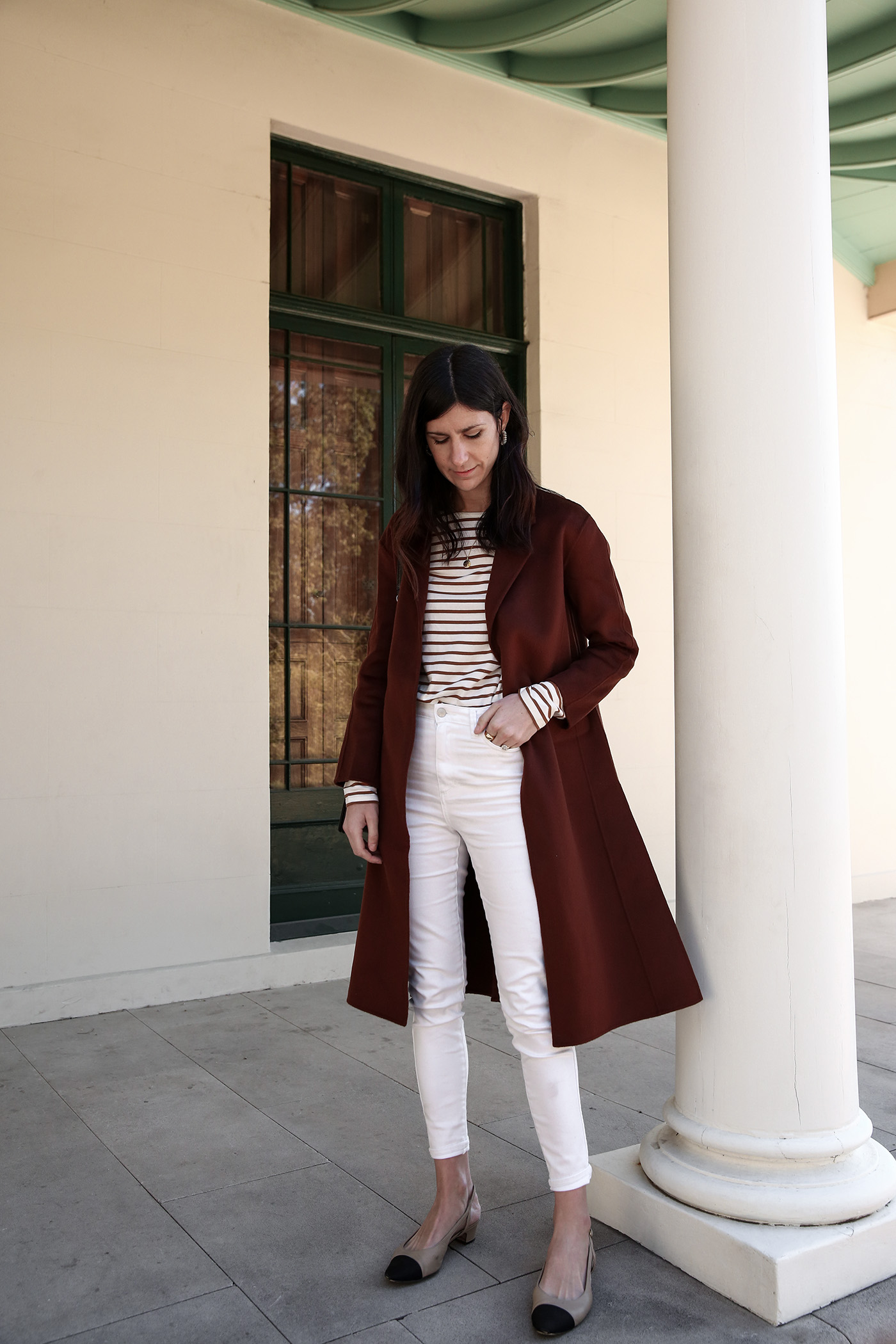
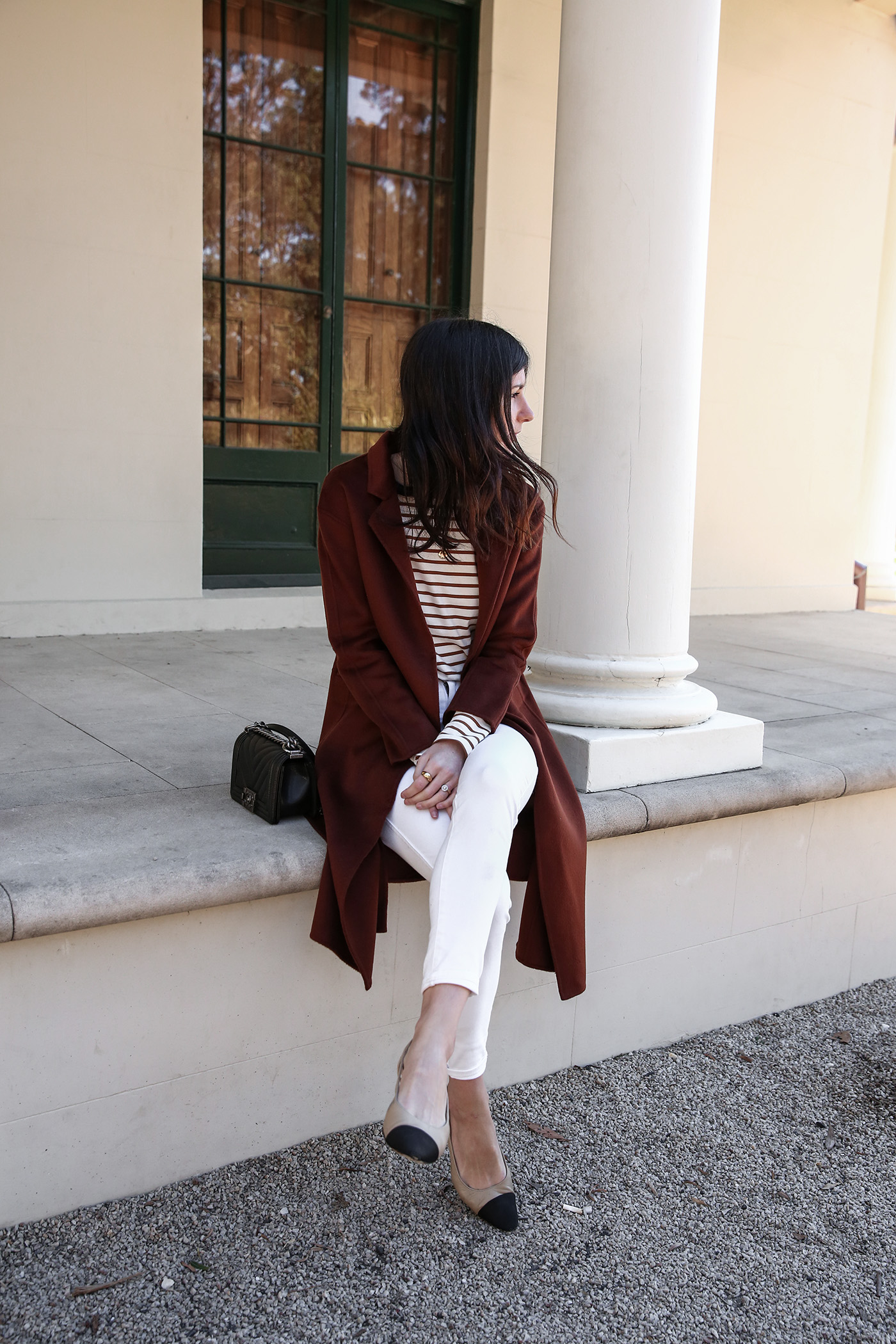
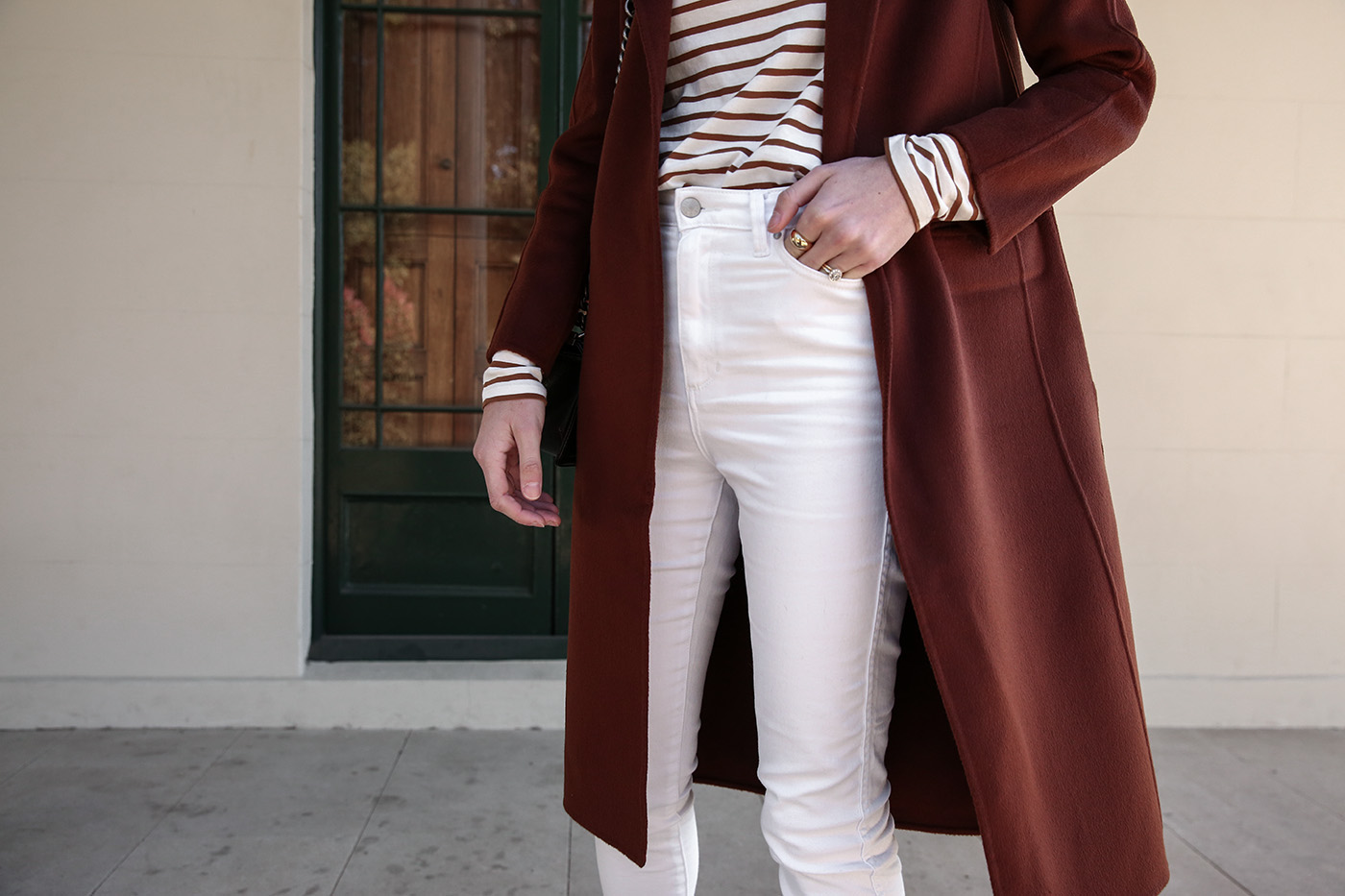

My capsule wardrobe days are long gone, now, though despite it no longer being the right fit for how I want to structure my wardrobe, the entire experience taught me a lot about how to approach my day-to-day style. The biggest learning for me was really putting a focus on matching the contents of my wardrobe with my lifestyle. And, as life would usually dictate, it’s not fluid; it’s evolved over the last few years and with it, my style has followed suit.
Particularly if you’re stretched for space, you want to be getting the most out of your wardrobe, and bust the myth that only 20% of your clothing is being worn 80% of the time.
Wearing Boden breton stripe top, Riders by Lee skinny jeans (also like this style), Mute by JL coat, Vaneli two tone pumps, Chanel chevron boy bag (mini), Reliquia earrings
As we’ve moved to Sydney, I’ve found myself now working in a casual office environment over a corporate headquarters; with three pets at home (who all shed a lot), I’m conscious of wearing clothing at home that isn’t too delicate or prone to picking up fur; and now that we’ve become homeowners, we’re dedicating less of our budget to dining out, and spending more of it on renovations and new furniture acquisitions. Needless to say, this change in lifestyle has invariably meant that many of my silk pieces are now going unworn, and I’ve become quite partial to a humble pair of jeans – essentially, my day-to-day uniform is a bit of a lazy girl’s guide to getting ready these days.
While I still love those dressier pieces – long sleeved silk blouses, and gorgeous little pencil skirts – they feel out of place at the office, and are for the most part, hugely impractical just for wearing around the home. Instead of clinging onto those styles, I’ve adapted my wardrobe as my lifestyle has evolved, making more space for the items I know I’ll reach for on a daily basis and have a synergy with my lifestyle, and dedicated far less space to garments that I find myself wearing only occasionally.
Where my wardrobe was once stuffed full of voluminous skirts, and feminine dresses, it is now a gold mine of classic denim staples, relaxed style shirts and oversized knit sweaters. Rather than fighting against this shift, I’ve really embraced it – I’m not apologetic about the fact that my style has relaxed, as my outfits have become so much more practical for the lifestyle I currently lead. Here are the three basic steps that helped me match up my wardrobe with my lifestyle…
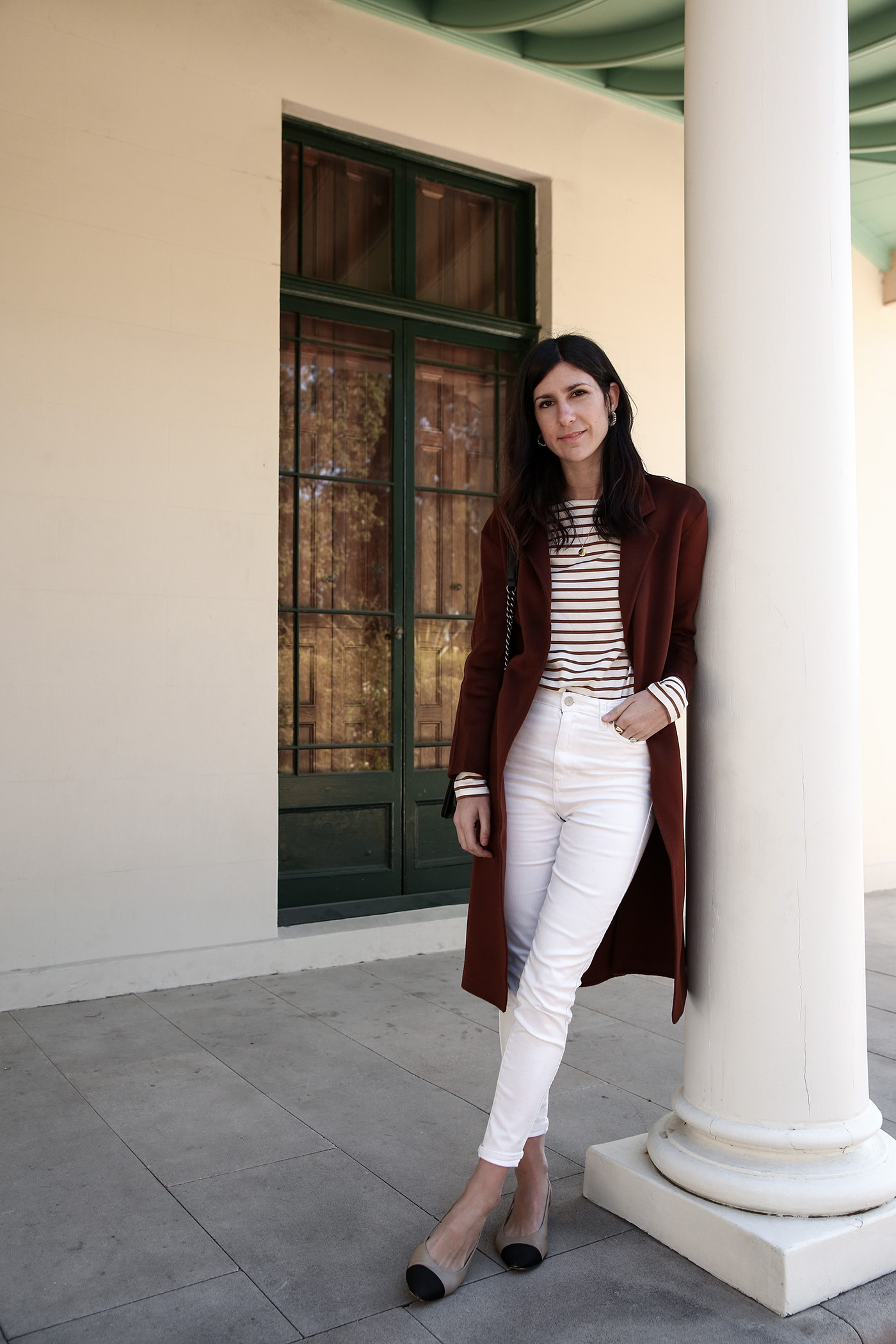
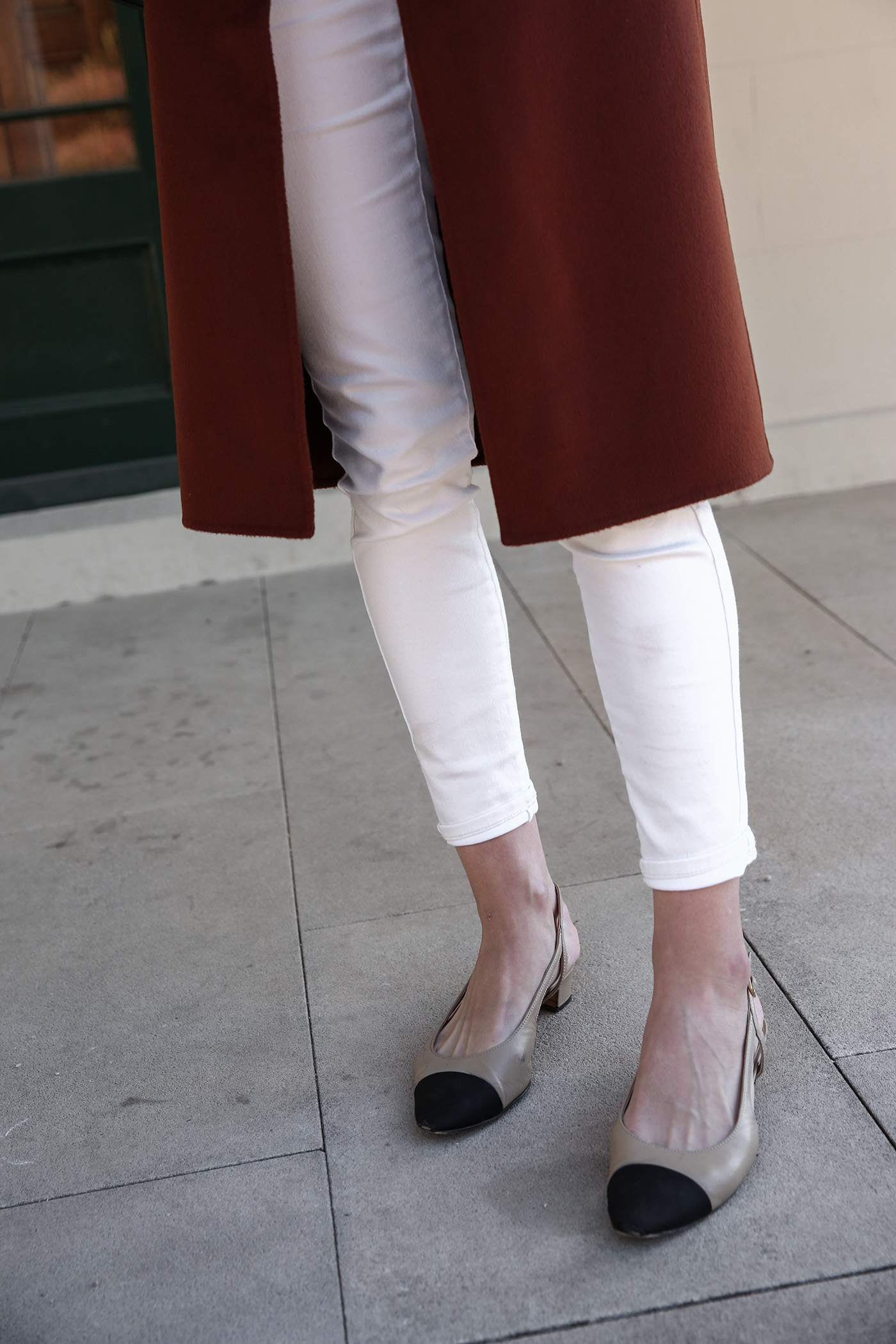
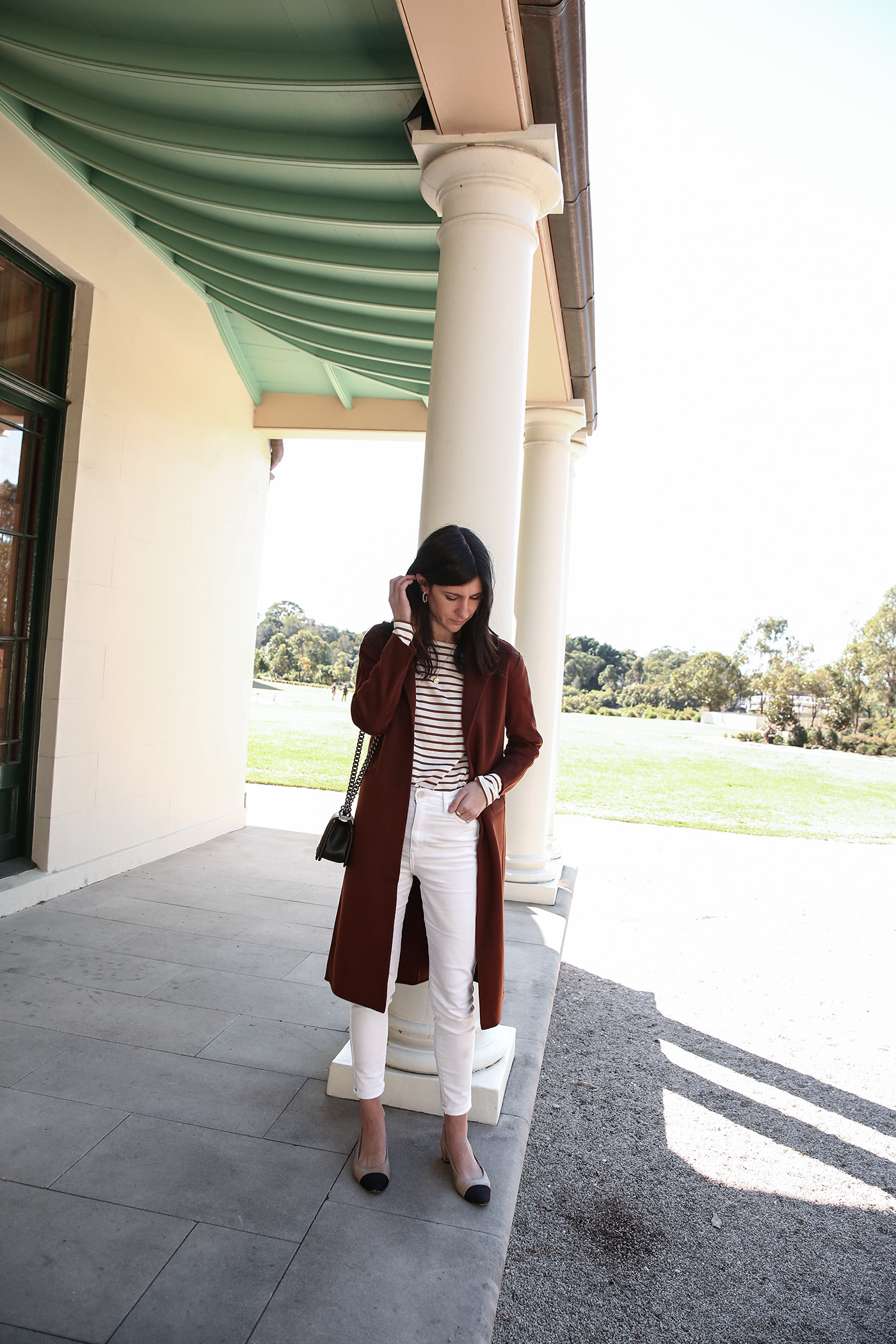
What does a typical week look like for you?
The key to identifying the right mix of clothing for your lifestyle is to look at a typical week in blocks. How much time are you spending working out or in gym clothes? Do you go out for dinner dates regularly? Do you have a corporate job or are you still a student at university?
There’s no point fixating on building up two-thirds of your wardrobe solely for casual clothes to wear on the weekend, if you spent five days a week working in a corporate office job (even if casual clothing really is your jam).
I’d recommend identifying not only what your typical week looks like (in terms of activities), but also identifying the make up of your wardrobe too, as it’ll allow you to easily pinpoint areas of your wardrobe where you are over-compensating, and areas where you might be somewhat lacking.
Some of the types of clothing categories to think about are: casual wear (for lounging around the house), professional wear (for wearing to a corporate office), formal wear (options to wear to weddings or other formal events), active wear (gym clothes or similar for exercise or hiking), smart casual (for creative work industries or when you want to elevate a relaxed outfit, and finally, occasion wear (for dates, partying, or semi-relaxed special occasions).
Be honest about what your wardrobe does, and doesn’t need
There’s no point in having a closet full of clothes but nothing to wear. What does your closet need more of? Are there any areas where you can perhaps cut back to just your favourites? What items do you tend to reach for the most? Is there anything you feel uncomfortable wearing?
You can read my post on decluttering here if you’re in need of a bit of inspiration, or aren’t quite sure where you should start.
It only takes one quick glance at my closet to see I don’t really need anything, and it’s because I’ve been practical about what I’ve been adding to my closet recently, that I really know where my the strengths of my wardrobe currently lie. I’ve parted with most corporate-style garments; these quickly became obsolete when I secured my current job over three years ago, though I have a few semi-formal pieces which can easily be dressed up if needed. For me, this is pretty sufficient as I’ll generally alternate between tailored trousers and a nice pair of jeans for day-to-day.
Make a Shopping List
It’s not hard to get side tracked when you’re browsing for something new. I know that whenever I pop into the shops, I usually find myself picking up a few cheeky ‘wild card’ items on my way to the dressing room. And when you try something on and it’s cute, it’s pretty difficult to talk yourself out of the purchase – I mean, if you’re anything like me, you’ve already planned out at least three ways to wear it with items you already own.
My best tip for keeping on track is to make a quick list of items that you do and don’t need in your phone, that you can easily refer back to before you find yourself in the dressing room with a bunch of impractical – yet gorgeous – pieces, which don’t match up with your lifestyle.
My list looks a little something like this… To buy: faded black jeans, classic and boyfriend style blazers, midi-length skirts, and ankle length trousers. To avoid buying: collared blouses in silk, white boyfriend-style jeans, grey cardigans and silk tanks.
Depending on your needs, your lifestyle, and your personal style, your own shopping list might look a little different, but, I do find that this is such an effective trick to buy clothing items that you’ll actually wear.
Do you base your wardrobe around your lifestyle, or do you buy clothing that you just love the look of (regardless of how it works for you, day-to-day)? x


Yea, ever since I started working from home I’ve been wearing my crazier pieces less and less because they just don’t fit in when I’m only going out for groceries or dinner at my parents. Not that I don’t love those pieces anymore, I just need places to wear them, haha.
And I looooove that coat! The color is amazing
http://www.closet-fashionista.com/
Pregnancy is this revelation on steroids. Match your wardrobe to your lifestyle and acquire as few things as possible because the period is so short (although it feels so long… ).
I work in a corporate environment so weekdays’ outfit usually mean pencil skirts and blouses (thanks for all those tips on wardrobe staples ;). I still keep more casual items like light-wash jeans and t-shirts for the weekend.
Even though that I’m shifting my focus to brands like Grana (hello cashmere sweaters), I still browse the sites of high-street brands (mostly Zara and Mango.). However, instead of roaming around aimlessly in the crowded shop, I browse their site for items (mostly made with linen and cotton) beforehand, collect the ones I’d actually like to try on and bring the list with me. I also try to consider items from Zara’s Join Life and Mango’s Take Action collection in the name of sustainability.
It’s great to see how your styles evolves and you still look very chic and classy 😉
Thank you so much for this! Love the outfit too.
I am really trying to simplify my wardrobe so thank you for this post! I love the striped tee you’re wearing and have never ordered from Boden before, so would you mind telling me what size you ordered? Thank you!
Author
Thank you lauren! I ordered the top in a size M, for a slightly loose fit. I’m typically a size S x
Love this post! So many people get caught up in the numbers of a capsule wardrobe or minimalism for the sake of it. AS you said, the key thing is matching your wardrobe with your life that way the pieces fit around a lifestyle and serve a purpose. The questions you provided are insightful and handy to keep in mind! thank you x
Author
Thanks so much Katherine – I’m glad to hear you find it helpful! Minimalism isn’t just about numbers, and while I’m not perfect (I try to minimise as much as possible but I don’t always have restraint), I think intention is important for sure – that’s the basis for which you can live a more meaningful life 🙂